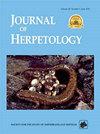一个根据非正统蝾螈卵泡数量估算最终离合器大小的模型
IF 0.8
4区 生物学
Q3 ZOOLOGY
引用次数: 0
摘要
摘要离合器大小的估计对于种群动态建模至关重要,但对于许多两栖动物物种来说,离合器可能很难观察到或在方法上有问题。直接发育的Plethodontidae的离合器大小是根据卵泡数量定期估计的。由于卵巢中开始发育的卵泡比最终达到完全大小并沉积的卵泡多得多,因此卵泡数量在单个女性的卵泡发育周期中会发生巨大变化,根据卵泡数量估计离合器大小的过程中具有高度的主观性。许多已发表的研究在如何从毛囊计数中确定离合器大小方面并不透明。一些研究人员使用阈值大小或其他特征来区分最终成熟和沉积的卵泡和不成熟的卵泡,以解决这种偏差,但我们的经验表明,这种方法仍然可能高估离合器大小。为了超越根据卵泡计数估计最终卵母细胞大小所固有的主观性,我们将大的Plethodon卵母细胞尺寸建模为雌性体型(吻部-出口长度,SVL)和卵泡直径的函数,然后使用该模型来预测可能沉积的成熟卵的数量。我们建议,这种方法提供了离合器大小和方差的合理估计,用于人口统计模型。本文章由计算机程序翻译,如有差异,请以英文原文为准。
A Model for Estimating Final Clutch Size from Follicle Counts in Plethodontid Salamanders
Abstract. Estimates of clutch sizes are essential for modeling population dynamics, yet for many species of amphibian, clutches can be difficult to observe or methodologically problematic to measure. Clutch sizes for direct-developing Plethodontidae are regularly estimated from counts of ovarian follicles. Because many more follicles begin to develop in an ovary than will ultimately reach full size and be deposited, follicle counts change dramatically over an individual female's follicle development cycle, and a high level of subjectivity is inherent in the process of estimating clutch sizes from follicle counts. Many published studies are not transparent in how they determine clutch sizes from follicle counts. Some investigators address this bias using threshold sizes or other characteristics to separate those follicles that will ultimately mature and be deposited from those that will not, but our experience indicates that such approaches still likely overestimate clutch sizes. To move beyond the subjectivity inherent in estimation of final clutch size from follicle counts, we modeled large Plethodon clutch size as a function of female body size (snout–vent length, SVL) and follicle diameter, then used that model to predict the likely number of mature eggs deposited. We propose that this approach provides reasonable estimates of clutch sizes and variances for use in demographic models.
求助全文
通过发布文献求助,成功后即可免费获取论文全文。
去求助
来源期刊

Journal of Herpetology
生物-动物学
CiteScore
1.60
自引率
0.00%
发文量
45
审稿时长
6 months
期刊介绍:
The Journal of Herpetology accepts manuscripts on all aspects on the biology of amphibians and reptiles including their behavior, conservation, ecology, morphology, physiology, and systematics, as well as herpetological education. We encourage authors to submit manuscripts that are data-driven and rigorous tests of hypotheses, or provide thorough descriptions of novel taxa (living or fossil). Topics may address theoretical issues in a thoughtful, quantitative way. Reviews and policy papers that provide new insight on the herpetological sciences are also welcome, but they must be more than simple literature reviews. These papers must have a central focus that propose a new argument for understanding a concept or a new approach for answering a question or solving a problem. Focus sections that combine papers on related topics are normally determined by the Editors. Publication in the Long-Term Perspectives section is by invitation only. Papers on captive breeding, new techniques or sampling methods, anecdotal or isolated natural history observations, geographic range extensions, and essays should be submitted to our sister journal, Herpetological Review.
 求助内容:
求助内容: 应助结果提醒方式:
应助结果提醒方式:


